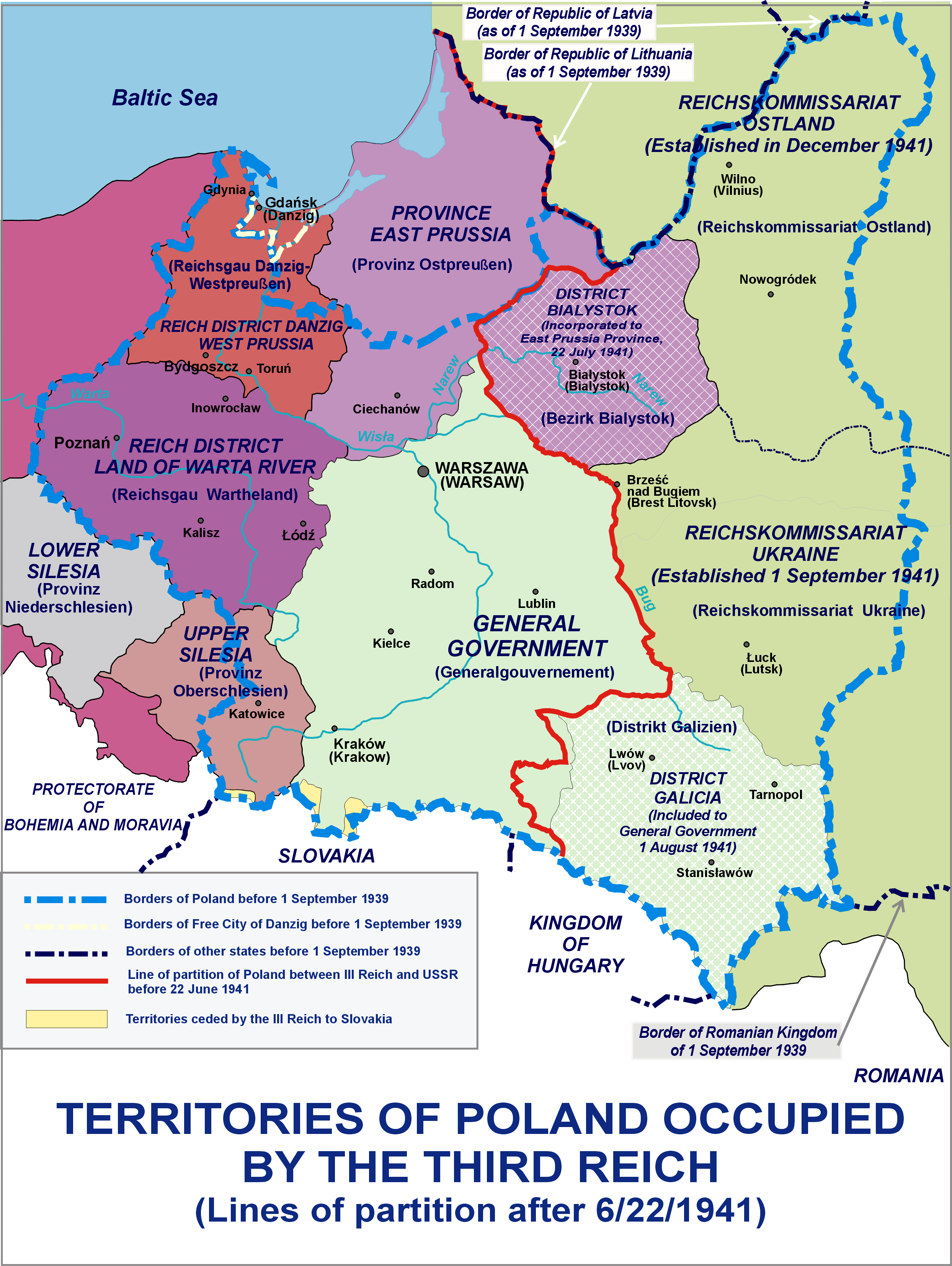|
Western Belorussia
Western Belorussia or Western Belarus ( be, Заходняя Беларусь, translit=Zachodniaja Bielaruś; pl, Zachodnia Białoruś; russian: Западная Белоруссия, translit=Zapadnaya Belorussiya) is a historical region of modern-day Belarus which belonged to the Second Polish Republic during the interwar period. For twenty years before the 1939 invasion of Poland, it was the northern part of the Polish Kresy macroregion. Following the end of World War II in Europe, most of Western Belorussia was ceded to the Soviet Union by the Allies, while some of it, including Białystok, was given to the Polish People's Republic. Until the dissolution of the Soviet Union in 1991, Western Belorussia formed the western part of the Byelorussian Soviet Socialist Republic (BSSR). Today, it constitutes the west of modern Belarus. Created by the USSR after the conquest of Poland, the new western provinces of Byelorussian SSR acquired from Poland included Baranavichy, Belastok, ... [...More Info...] [...Related Items...] OR: [Wikipedia] [Google] [Baidu] |
Byelorussian Soviet Socialist Republic
The Byelorussian Soviet Socialist Republic (BSSR, or Byelorussian SSR; be, Беларуская Савецкая Сацыялістычная Рэспубліка, Bielaruskaja Savieckaja Sacyjalistyčnaja Respublika; russian: Белорусская Советская Социалистическая Республика, Byelorusskaya Sovyetskaya Sotsialisticheskaya Respublika or russian: links=no, Белорусская ССР, Belorusskaya SSR), also commonly referred to in English as Byelorussia, was a Republics of the Soviet Union, republic of the Soviet Union (USSR). It existed between 1920 and 1922, and from 1922 to 1991 as one of Republics of the Soviet Union, fifteen constituent republics of the USSR, with its own legislation from 1990 to 1991. The republic was ruled by the Communist Party of Byelorussia and was also referred to as Soviet Byelorussia or Soviet Belarus by a number of historians. Other names for Byelorussia included White Russian Soviet Socialist Rep ... [...More Info...] [...Related Items...] OR: [Wikipedia] [Google] [Baidu] |
Belorussian SSR In 1940 After Annexation Of Eastern Poland
Belarusian may refer to: * Something of, or related to Belarus * Belarusians, people from Belarus, or of Belarusian descent * A citizen of Belarus, see Demographics of Belarus * Belarusian language * Belarusian culture * Belarusian cuisine * Byelorussian Soviet Socialist Republic See also * * Belorussky (other) Belorussky (masculine), Belorusskaya (feminine), or Belorusskoye (neuter) may refer to: *Belorussky Rail Terminal, a rail terminal in Moscow, Russia * Belorussky (settlement), a settlement in Pskov Oblast, Russia * Belorusskaya-Koltsevaya, a station ... {{disambig Language and nationality disambiguation pages ... [...More Info...] [...Related Items...] OR: [Wikipedia] [Google] [Baidu] |
University Of Kansas
The University of Kansas (KU) is a public research university with its main campus in Lawrence, Kansas, United States, and several satellite campuses, research and educational centers, medical centers, and classes across the state of Kansas. Two branch campuses are in the Kansas City metropolitan area on the Kansas side: the university's medical school and hospital in Kansas City, Kansas, the Edwards Campus in Overland Park. There are also educational and research sites in Garden City, Hays, Leavenworth, Parsons, and Topeka, an agricultural education center in rural north Douglas County, and branches of the medical school in Salina and Wichita. The university is a member of the Association of American Universities and is classified among "R1: Doctoral Universities – Very high research activity". Founded March 21, 1865, the university was opened in 1866, under a charter granted by the Kansas State Legislature in 1864 and legislation passed in 1863 under the State Cons ... [...More Info...] [...Related Items...] OR: [Wikipedia] [Google] [Baidu] |
Pinsk Region
Pinsk Region (Pinsk Voblast, be, Пінская вобласць, russian: Пинская Область) was a territorial unit in the Byelorussian Soviet Socialist Republic created after the annexation of West Belarus into the BSSR in November 1939. The administrative centre of the province was the city of Pinsk, the oblast was founded on 4 December 1939 with 16.3 thousand square km and 533.6 thousand people. The Voblast consisted of 11 raions: * Hantsavitski *Davyd-Haradotski * Drahichynski *Zhabchytski * Ivanauski *Lahishynski *Lyeninski * Luninyetski * Pinski *Stolinski *Cyelyekhanski With four cities: Pinsk, Davyd-Haradok, Luninyets and Stolin Stolin ( be, Сто́лін; uk, Сто́лін; russian: Сто́лин; pl, Stolin; Yiddish/Hebrew: סטולין) is a town in the Stolin District in Brest Region of Belarus. It is the centre of the largest district in Brest Region. The popu ... On January 8, 1954, due to the administrative reform of the BSSR the Oblast w ... [...More Info...] [...Related Items...] OR: [Wikipedia] [Google] [Baidu] |
Vileyka Voblast
russian: Вилейская область , conventional_long_name = Vileyka Voblast , common_name = Vileyka , subdivision = Voblast , nation = the Byelorussian SSR , year_start = 1939 , date_start = December 4 , year_end = 1944 , date_end = September 20 , p1 = Wilno Voivodeship (1926–1939) , flag_p1 = Flag of Poland.svg , s1 = Maladzyechna Voblast , flag_s1 = Flag of the Byelorussian Soviet Socialist Republic (1937-1951).svg , image_flag = , image_map = Вілейская вобласць БССР (студзень 1940).svg , image_map_caption = Map of the Byelorussian SSR in 1940,of which Vileyka Voblast was a part. , capital = Vileyka , coordinates = , political_subdiv = 22 raions , stat_year1 = 1941 , stat_area1 ... [...More Info...] [...Related Items...] OR: [Wikipedia] [Google] [Baidu] |
Belastok Region
Belastok Voblast or Belostok Oblast ( be, Беластоцкая вобласць, Biełastockaja vobłasć, russian: Белостокская Область, pl, Obwód białostocki) was a short-lived territorial unit in the Belarusian Soviet Socialist Republic (BSSR) during World War II from September 1939 until Operation Barbarossa of 22 June 1941 and again for a short period in 1944. The administrative center of the newly created voblast was the pl, Białystok renamed Belastok ( be, Беласток). History Integration into the Soviet Union From 23 September to October 1939, the secretary of the central committee of the Belarusian SSR lived in Bialystok due to the protracted procedures for the transfer of the territories west of Bialystok by German troops to Białystok. While the leaders of provincial boards and were immediately established at the level of the Central Committee and the Military Front Council, the lower structures (poviat, gmina) were established "in con ... [...More Info...] [...Related Items...] OR: [Wikipedia] [Google] [Baidu] |
Baranavichy Voblast
russian: Барановичская Область , common_name = Baranavichy , subdivision = Voblast , nation = Byelorussian SSR , p1 = Navahrudak Voblast , flag_p1 = Flag of the Byelorussian Soviet Socialist Republic (1937-1951).svg , s1 = Hrodna Voblast , flag_s1 = Flag of Byelorussian SSR.svg , s2 = Maladzyechna Voblast , flag_s2 = Flag of Byelorussian SSR.svg , s3 = Brest Voblast , flag_s3 = Flag of Byelorussian SSR.svg , s4 = Minsk Voblast , flag_s4 = Flag of Byelorussian SSR.svg , image_flag = Flag of the Byelorussian Soviet Socialist Republic (1937-1951).svg , image_map = Obwód baranowicki 1944.png , image_map_caption = Baranavichy Voblast (red) on the map of Byelorussian SSR in 1944 , capital = Baran ... [...More Info...] [...Related Items...] OR: [Wikipedia] [Google] [Baidu] |
Soviet Invasion Of Poland
The Soviet invasion of Poland was a military operation by the Soviet Union without a formal declaration of war. On 17 September 1939, the Soviet Union invaded Poland from the east, 16 days after Nazi Germany invaded Poland from the west. Subsequent military operations lasted for the following 20 days and ended on 6 October 1939 with the two-way division and annexation of the entire territory of the Second Polish Republic by Nazi Germany and the Soviet Union. This division is sometimes called the Fourth Partition of Poland. The Soviet (as well as German) invasion of Poland was indirectly indicated in the "secret protocol" of the Molotov–Ribbentrop Pact signed on 23 August 1939, which divided Poland into " spheres of influence" of the two powers. German and Soviet cooperation in the invasion of Poland has been described as co-belligerence. The Red Army, which vastly outnumbered the Polish defenders, achieved its targets, encountering only limited resistance. Some 320,000 Pole ... [...More Info...] [...Related Items...] OR: [Wikipedia] [Google] [Baidu] |
Dissolution Of The Soviet Union
The dissolution of the Soviet Union, also negatively connoted as rus, Разва́л Сове́тского Сою́за, r=Razvál Sovétskogo Soyúza, ''Ruining of the Soviet Union''. was the process of internal disintegration within the Soviet Union (USSR) which resulted in the end of the country's and its federal government's existence as a sovereign state, thereby resulting in its constituent republics gaining full sovereignty on 26 December 1991. It brought an end to General Secretary Mikhail Gorbachev's (later also President) effort to reform the Soviet political and economic system in an attempt to stop a period of political stalemate and economic backslide. The Soviet Union had experienced internal stagnation and ethnic separatism. Although highly centralized until its final years, the country was made up of fifteen top-level republics that served as homelands for different ethnicities. By late 1991, amid a catastrophic political crisis, with several republics alr ... [...More Info...] [...Related Items...] OR: [Wikipedia] [Google] [Baidu] |
Polish People's Republic
The Polish People's Republic ( pl, Polska Rzeczpospolita Ludowa, PRL) was a country in Central Europe that existed from 1947 to 1989 as the predecessor of the modern Republic of Poland. With a population of approximately 37.9 million near the end of its existence, it was the second-most populous communist and Eastern Bloc country in Europe. It was also one of the main signatories of the Warsaw Pact alliance. The largest city and official capital since 1947 was Warsaw, followed by the industrial city of Łódź and cultural city of Kraków. The country was bordered by the Baltic Sea to the north, the Soviet Union to the east, Czechoslovakia to the south, and East Germany to the west. The Polish People's Republic was a socialist one-party state, with a unitary Marxist–Leninist government headed by the Polish United Workers' Party (PZPR). The country's official name was the "Republic of Poland" (') between 1947 and 1952 in accordance with the transitional Small Constit ... [...More Info...] [...Related Items...] OR: [Wikipedia] [Google] [Baidu] |
Białystok
Białystok is the largest city in northeastern Poland and the capital of the Podlaskie Voivodeship. It is the tenth-largest city in Poland, second in terms of population density, and thirteenth in area. Białystok is located in the Białystok Uplands of the Podlachian Plain on the banks of the Biała River, by road northeast of Warsaw. It has historically attracted migrants from elsewhere in Poland and beyond, particularly from Central and Eastern Europe. This is facilitated by the nearby border with Belarus also being the eastern border of the European Union, as well as the Schengen Area. The city and its adjacent municipalities constitute Metropolitan Białystok. The city has a warm summer continental climate, characterized by warm summers and long frosty winters. Forests are an important part of Białystok's character and occupy around (18% of the administrative area of the city) which places it as the fifth-most forested city in Poland. The first settlers arrived in th ... [...More Info...] [...Related Items...] OR: [Wikipedia] [Google] [Baidu] |
Allies Of World War II
The Allies, formally referred to as the United Nations from 1942, were an international military coalition formed during the Second World War (1939–1945) to oppose the Axis powers, led by Nazi Germany, Imperial Japan, and Fascist Italy. Its principal members by 1941 were the United Kingdom, United States, Soviet Union, and China. Membership in the Allies varied during the course of the war. When the conflict broke out on 1 September 1939, the Allied coalition consisted of the United Kingdom, France, and Poland, as well as their respective dependencies, such as British India. They were soon joined by the independent dominions of the British Commonwealth: Canada, Australia, New Zealand and South Africa. Consequently, the initial alliance resembled that of the First World War. As Axis forces began invading northern Europe and the Balkans, the Allies added the Netherlands, Belgium, Norway, Greece, and Yugoslavia. The Soviet Union, which initially ha ... [...More Info...] [...Related Items...] OR: [Wikipedia] [Google] [Baidu] |



.jpg)

